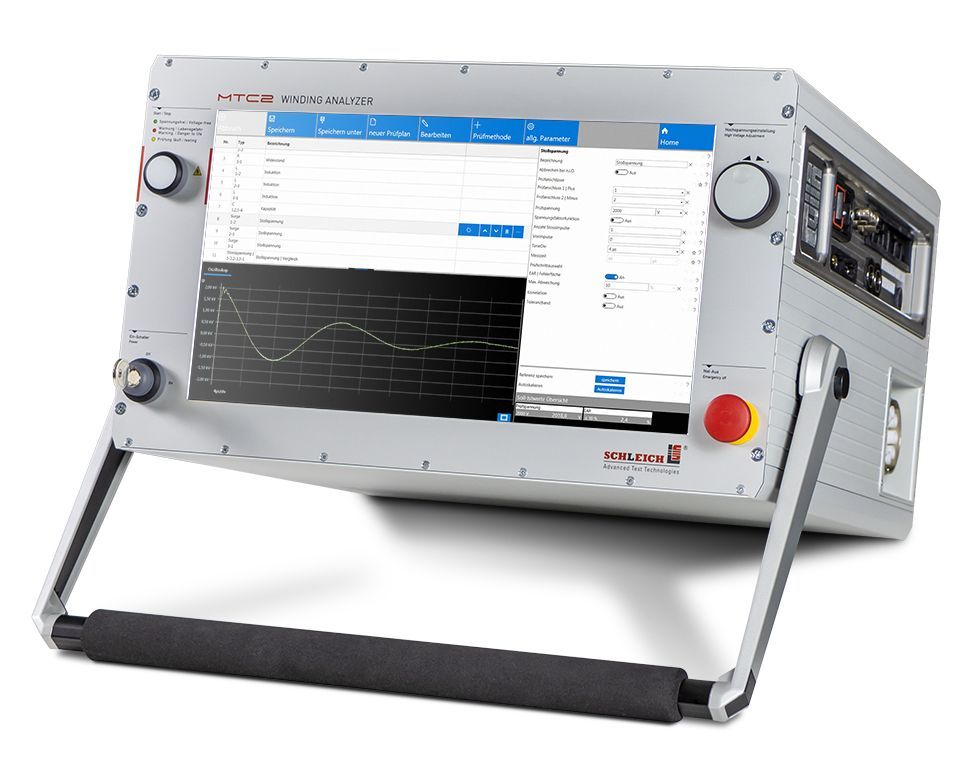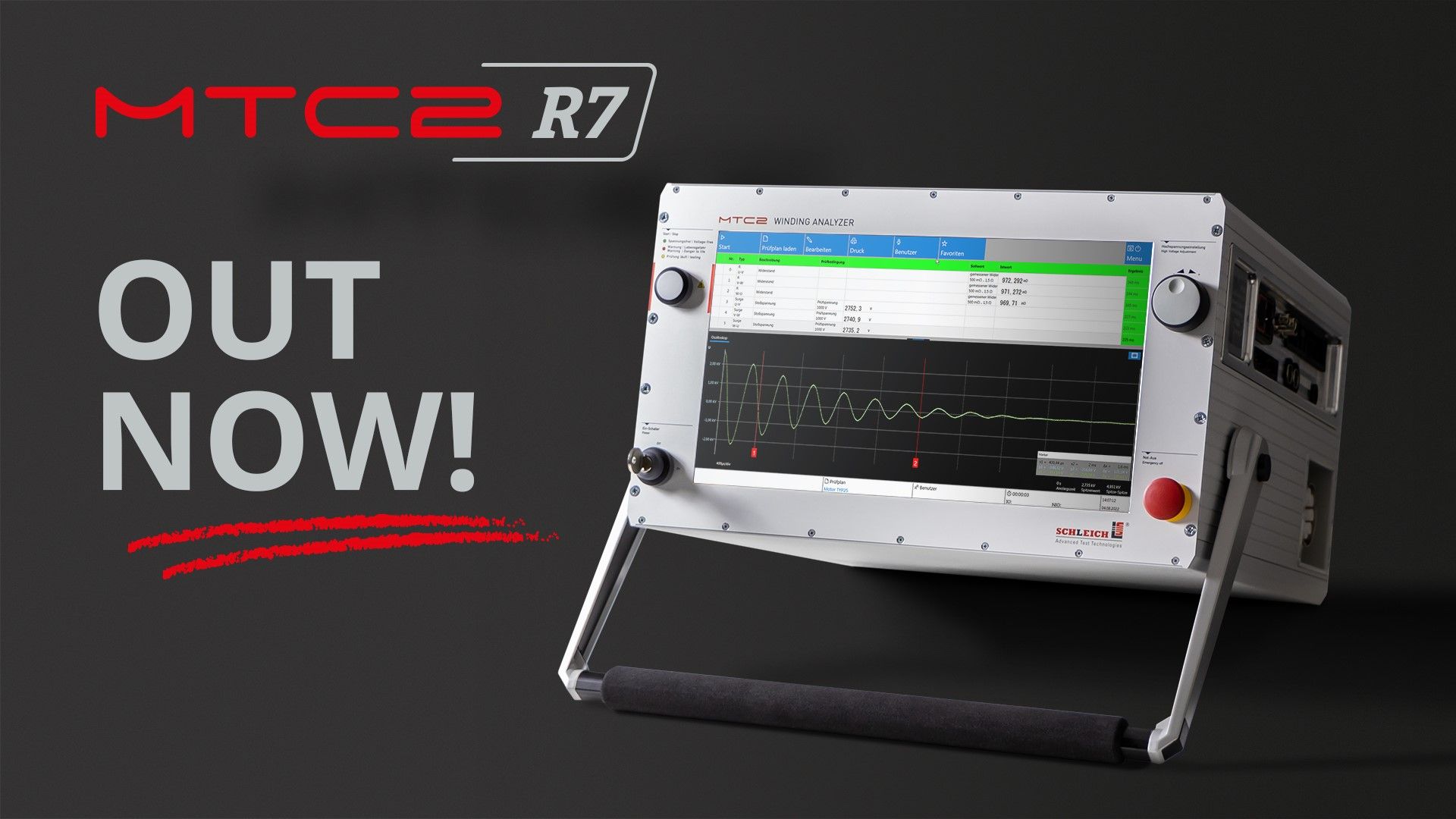
Slide title
Write your caption hereButton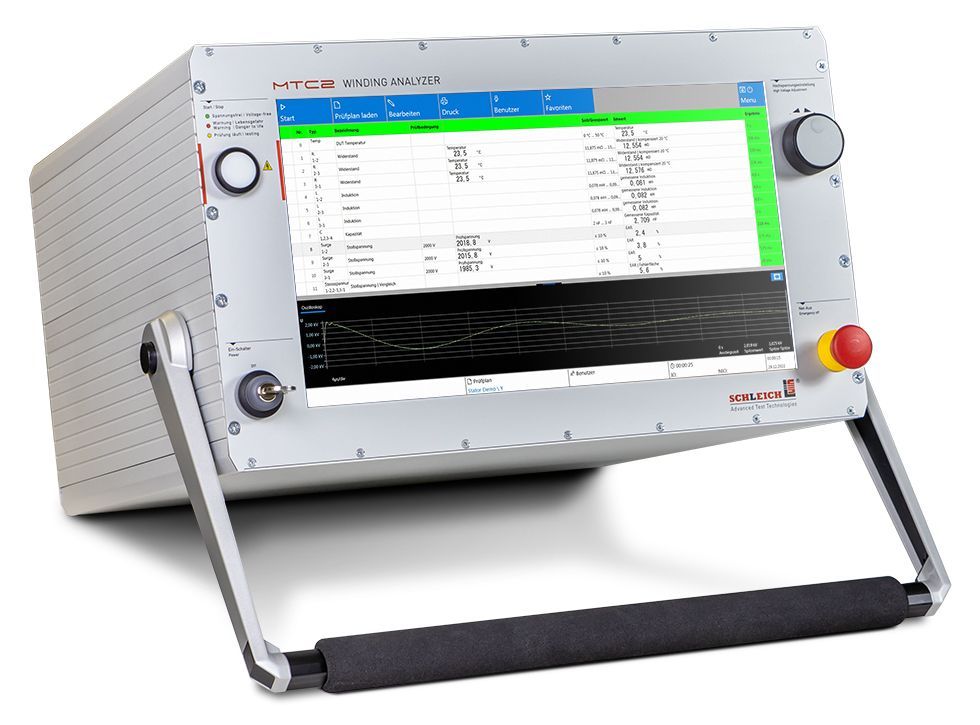
Slide title
Write your caption hereButton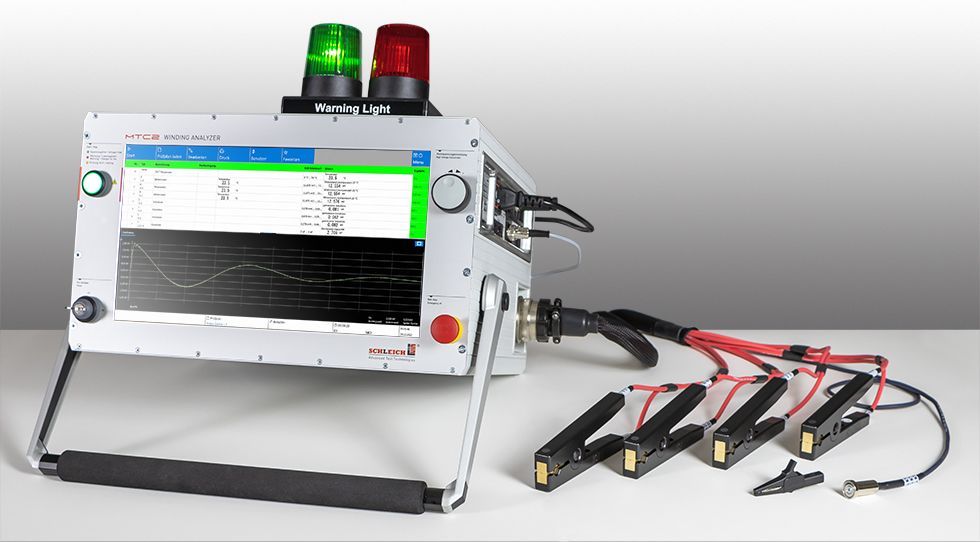
Slide title
Write your caption hereButton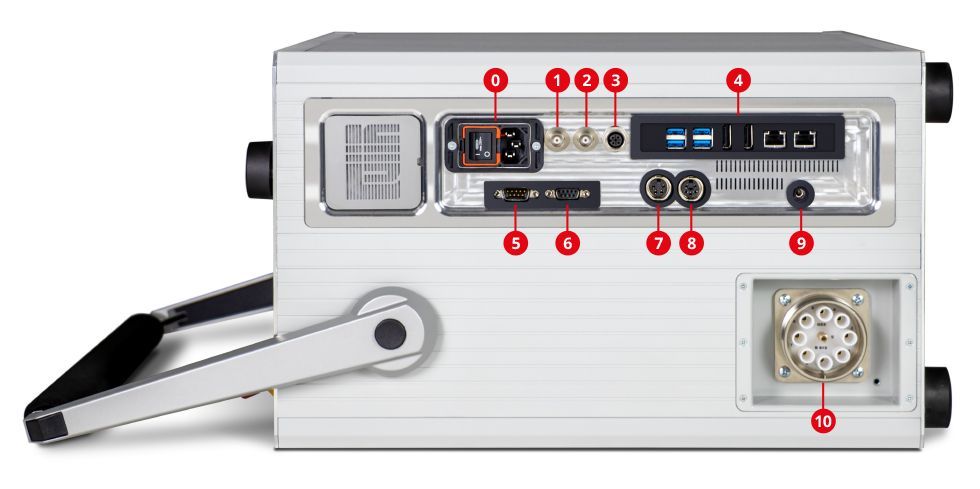
Slide title
Write your caption hereButton
Schleich MTC2 R7 Winding Analyzer
MTC2 R7 Surge Tester
The MTC2 R7 redefines surge voltage testing
A deeper look into the winding – the surge voltage tester par excellence – the ultimate surge tester. No other tester offers so much performance variety. Reliably test stators, armatures, coils and windings of all kinds. Over 40 years of pioneering spirit, deep know-how, consistent optimization and permanent R & D activities of our engineers and technicians are the basis for this state-of-the-art surge tester.
Designed & Made in Germany.
Trailblazing surge voltage test The latest hardware technologies paired with state-of-the-art .NetCore software come into play. This significantly increases the accuracy of the individual test methods and of the measurement speeds.
The MTC2 R7 is the high-end device for testing windings, coils and armatures.
SCHLEICH PATENT:
The surge voltage test is capable of a pulse frequency of up to 50 Hz. The test time of the partial discharge inception voltages can thereby be reduced by up to 75 %.
SCHLEICH PATENT:
The SCHLEICH “peak to peak” method for the detection of voltage-dependent winding faults has been completely revised and enables highly sensitive fault detection even in the case of coils with very high numbers of windings, connected in series or parallel.
Winding tests in its purest form.
The MTC2 R7 redefines surge voltage testing.
The latest hardware technologies paired with state-of-the-art .NetCore software come into play. This significantly increases the accuracy of the individual test methods and of the measurement speeds.
The MTC2 R7 is the high-end device for testing windings, coils and armatures.
SCHLEICH PATENT:
The surge voltage test is capable of a pulse frequency of up to 50 Hz. The test time of the partial discharge inception voltages can thereby be reduced by up to 75 %.
SCHLEICH PATENT:
The SCHLEICH “peak to peak” method for the detection of voltage-dependent winding faults has been completely revised and enables highly sensitive fault detection even in the case of coils with very high numbers of windings, connected in series or parallel.
Manifold connection possibilities
A test device can be as good as it is – it must fit into an established infrastructure and extend and refine existing possibilities. For this reason, the discreetly recessed connection panel of the MTC2 R7 base model has been placed on the side to make it easily accessible. Whether you operate the device on a table or standing on the floor, all connections are conveniently available at all times.
Rack and 19″ version:
All connections are now located on the rear panel. This makes it very easy to integrate the MTC2 R7 into a 19″ rack. For optimal remote control, the device in this version has an additional PLC I/O interface, which is always installed as standard. Additionally RSS232, Ethernet or various field buses are expandable (Profinet, EtherCat or ProfiBus)..
SPS I/O Interface
Outputs GO, NOGO, test running, ready0status and 8 * freely configurable outputs
Inputs Start, 4 * freely configurable inputs
5 Test leads
5 test leads give you the possibility to contact all relevant winding connections at once. The 3 phase connections as well as the star point (if available and accessible) are connected with 4 test leads. The fourth test connection at the star point gives you a unique increase in test accuracy. The fifth test connection is connected to the stator/motor housing. It is required for the insulation test between the winding and the laminated core.
Automatic test method switching
After connecting the device under test, the MTC2 R7 automatically tests on all 5 clamps. Thanks to the integrated test method switching, you no longer have to reconnect any connections by hand. This saves time and avoids errors.
Do you usually always need more than 4 measuring connections, e.g. to contact additional sensors or unconnected devices under test? Then an extension of the MTC2 R7 to a total of 8 measuring connections + frame is possible.
The surge voltage test
The surge voltage with standard-compliant edge steepness leaves no fault undetected. Modern automatic evaluations facilitate the subsequent fault analysis for you.
The MTC2 R7 features surge voltage testing with a pulse frequency of up to 50 Hz. This results in a considerable decrease in test cycle time, which is particularly advantageous in combination with the partial discharge inception voltage measurement (RPDIV). (optional extension)
Partial discharge test with surge voltage
The standard-compliant PD test can also be integrated. It gives you information about critical insulation weaknesses and the suitability for operation with frequency converters. Here SCHLEICH pursues two strategies to obtain good measurement results: both on the stator and on the fully assembled motor:
Motors are measured with a coupler in the test lead.
Stators are measured using an antenna.
Until now, the partial discharge inception voltage measurement was a particularly time-consuming test. For a 3-phase device under test, for example, this could take 8.5 minutes (depending on the parameterization of the test steps). With the new, patented surge voltage test of the MTC2 R7, it is possible to reduce test duration by approx. 75 % (with the same parameterization of the test steps). (optional extension)
Insulation resistance test
To achieve highly accurate measurement results for your resistance measurement comparison between the 3 phases, the resistance test is performed using four-wire technology. This automatically compensates for the resistances in the test leads. In addition, the MTC2 R7 detects the room temperature to compensate for any temperature influence. The resistance test including temperature compensation is always a part of the MTC2 R7.
By using SCHLEICH Kelvin clamps, compensation of the contact resistances at the clamping points to the winding is ensured. Only in this manner resistances of less than 10 Ω can be measured with high precision.
High voltage test AC
In addition, the AC high voltage test can also be applied. It is also automatically switched to the device under test via the automatic test method switchover. (optional extension)
Direction of rotation test
To check the rotating field of a stator, the MTC2 R7 simulates a rotating field supply at the three winding connections of a stator, connected in a star or delta connection. A special probe placed in the stator detects the sense of rotation which is then evaluated by the MTC2 R7. (optional extension)
Armature test
A software assistant offers optimized support for the armature test. It guides you through the test so that no lamella will be missed. The manual test is performed using test probes or an armature adapter. The automatic test uses a fully automatic contacting adapter. Either the armature or the contacting adapter rotates to contact the lamellae precisely and reliably. An automatic position adjustment is built in for this purpose. Ask us – we can supply you with the complete solution to suit your armatures. (optional extension)
Software
The new software is based on the latest .Net technology and has been completely redesigned. The MTC2 R7 features modern and clear views that enable intuitive operation. To ensure operation via touch during mobile use or in the workshop, a variety of settings can be displayed enlarged. Coupled with a big touch keyboard, the software allows operation even without mouse and keyboard.
Winding tests in its purest form.
The fastest partial discharge test of all times thanks to patented 50 Hz pulse-frequency technology
Unsurpassed reliable winding fault detection due to the new, patented peak-to-peak measurement method
The outstanding Full-HD touch display measures 15.6″ and enables optimal viewing and operation
Fully integrated RLC test
4 test connections in four-wire technology + 1 frame connection
Unrivaled fully automatic test method switching to all test connections
Virtually unlimited compatibility thanks to built-in Windows 10® | 11® PC
Various interfaces for remote control (Ethernet, RS232, fieldbus)
Unique test method diversity thanks to modular configuration and expansion!
MTC2 R7 Applications
The many connection capabilities of the MTC2 R7 allow for a custom setup of the test area. Whether a warning and result light is used or a safety circuit (e.g. from a protective fence or test cover) is to be integrated, the MTC2 R7 allows for this with ease.
Motor repair
The MTC2 R7 comes ready for instant measurement. After a few motor parameters have been entered, the test can start. Either an autotest can be performed based on the entered motor parameters or a user-defined test sequence can be initiated.
Virtually all motor data including a picture can be stored. This simplifies the retrieval of motor data and the corresponding measurement results. The motor data are also printed directly on the SCHLEICH standard protocol in connection with the measurement results.
Motor repair | Manual testing of a rotor
Using special test probes and an armature booster, the rotor is tested according to the lamellar method. This usually involves testing between two adjacent lamellae. A quarter or half circle measurement is also possible. The built-in armature assistant software reliably guides the operator through the test.
Motor production
The MTC2 R7 can easily be incorporated into a production line. The housing measurements are based on a 19″ rack, which allows for seamless integration of the test device. The added interfaces enable full remote operation of the device by a PC control system.
For different types of devices under test, almost any number of test sequences can be stored in the MTC2 R7. These test sequences can be accessed and launched through an interface.
All test results can be accessed through an interface and can thereby be stored in a central database via the control PC. It is also possible to store the results locally on the test device or directly in a network.
Measurement technology advantages at a glance.
Autotest
automatic stator, motor testing
fully automatic fault analysis
Surge voltage
6, 12, 15, 25, 30, 40 and 50 kV
rise time 100 – 500 ns in accordance with IEEE std 522-2004 (depending on the device under test)
optional pulse frequency up to 50 Hz supported (depending on test voltage)
automatic and manual surge voltage test
1-, 2- and 3-phase
automatic evaluation
4 different evaluation methods incl. correlation (SCHLEICH patent)
optional armature booster for testing DC armatures
High voltage DC
6, 12, 15, 25, 30, 40 and 50 kV
manually, individually adjustable
Auto programmable
Step voltage measurement
Insulation resistance DC
6, 12, 15, 25, 30, 40 and 50 kV
in accordance with VDE 0701
1 MΩ – 100 GΩ
optional custom measuring range up to 1 teraohm
Temperature compensation of the insulation resistance to 40 °C
PI (Polarisation Index) and DAR (Dielectric Absorption Ratio)
6, 12, 15, 25, 30, 40 and 50 kV
automatic measurement
Partial discharge surge (optional)
6, 12, 15 and 25 kV
in accordance with DIN EN 60034-18:2014
measurement of
PDIV – partial discharge inception voltage
RPDIV – repetitive partial discharge inception voltage
RPDEV – repetitive partial discharge extinction voltage
PDEV – partial discharge extinction voltage
Measurement via antenna – ideal for stators
Measurement via coupler in the test line – ideal for motors
Resistance
1-, 2- and 3-phase
1 mΩ – 1 MΩ
Determine resistance unbalance between the 3 phases
High-precision four-wire measurement
Room temperature compensation of the temperature-dependent Cu or Al resistors referred to 20 °C or 25 °C
High voltage AC (optional)
up to 6 kV, 100 mA
1-, 2- and 3-phase
Connections
4 + 1 | 4 x Winding connections plus 1 x stator/motor housing
8 + 1 | 8 x Winding connections plus 1 x stator/motor housing (optional)
Automation
digital I/Os, (inputs/outputs 24 V to PLC)
Communication interfaces (optional)
RS232 via SCHLEICH communication protocol
LAN via SCHLEICH communication protocol
LAN via TCP/IP
EtherCat
ProfiNet
custom solutions …
Database
MongoDB / PostgreSQL
MS-SQL (optional)
Test plans
Local storage
Network storage
Test plan/test parameter setting by a PC or other control system
and more …
Test results
Local storage
Network storage
Transmission to a PC or other controller
Transmission to an MES
Transmission to a CAQ system
Transmission to SAP®
and more …
Access control
Power switch with key
Password protection
built-in user management
Power supply
Suitable for worldwide use: voltage range 90 – 250 V, 47 – 63 Hz
MTC2 R7 Variants
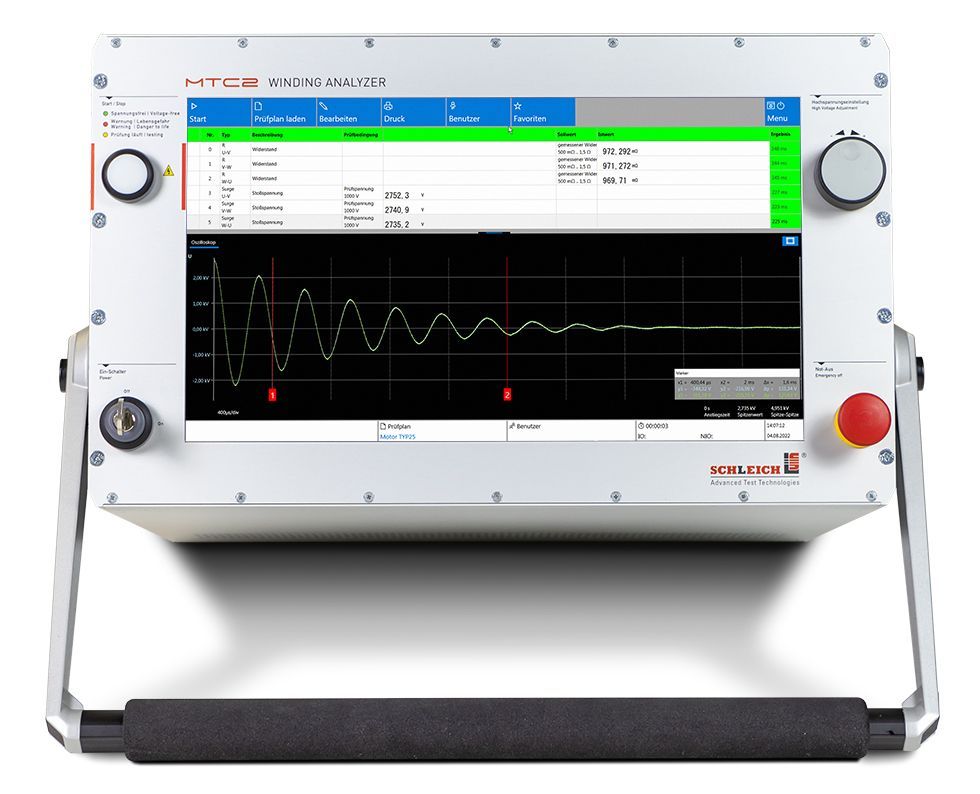
MTC2 R7 6 kV
surge test 0–6 kV
resistance 4-wire measurement
Inductance Capacitance Test NO
insulation 0–6 kV ˭max. 500 GΩ
polarization index Vmax like surge test
high voltage DC 0–6 kV ˭
test terminals T1, T2, T3, Y, frame
test cover possible
delivery order-related manufacturing
Test leads plug-in on the right side of the device
Number of test leads 5 | automatic switch-over in the test device
Housing test lead 1 | stator/motor frame
Kelvin clamps optional
Surge capacitance 100 nF; customer-specific adaptation possible
Surge energy 1,8 J
Surge current 800 A; customer-specific adaptation possible
Pulse rise time 100 – 500 ns; according to IEC 60034-18-41
Refresh rate 5 – 8 Hz
Partial discharge
—
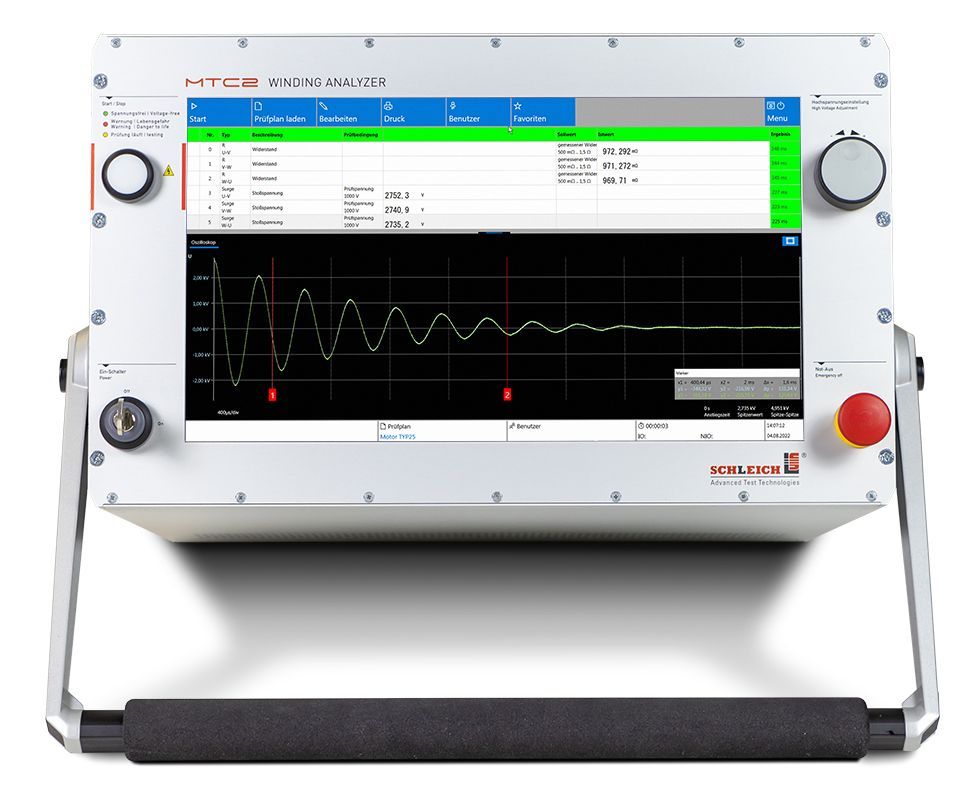
MTC2 R7 6 kV | RLC
surge test 0–6 kV
resistance 4-wire measurement
Inductance Capacitance Test YES
insulation 0–6 kV ˭max. 500 GΩ
polarization index Vmax like surge test
high voltage DC 0–6 kV ˭ test terminals T1, T2, T3, Y, frame
test cover possible
delivery order-related manufacturing
Test leads plug-in on the right side of the device
Number of test leads 5 | automatic switch-over in the test device
Housing test lead 1 | stator/motor frame
Kelvin clamps optional
Surge capacitance 100 nF; customer-specific adaptation possible
Surge energy 1,8 J
Surge current 800 A; customer-specific adaptation possible
Pulse rise time 100 – 500 ns; according to IEC 60034-18-41
Refresh rate 5 – 8 Hz
Partial discharge
—
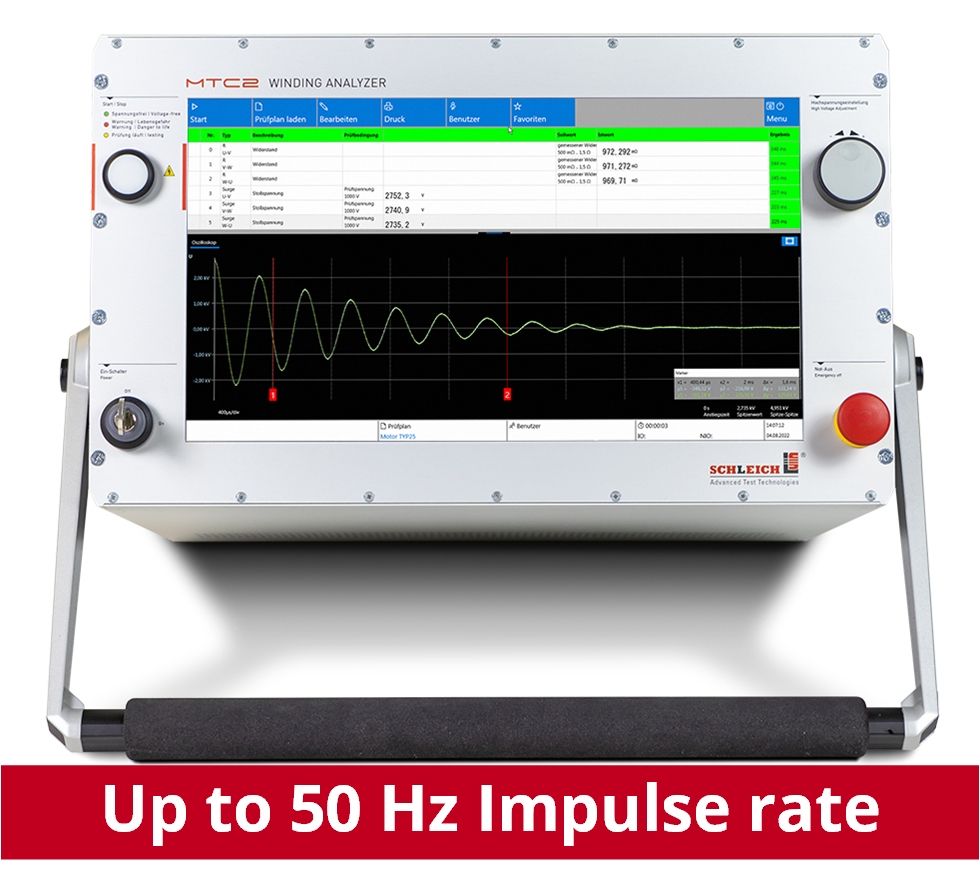
MTC2 R7 6 kV | PD
Test methods Surge · R · PD
surge test 0–6 kV
resistance 4-wire measurement
Inductance Capacitance Test NO
insulation 0–6 kV ˭max. 500 GΩ
polarization index Vmax like surge test
high voltage DC 0–6 kV ˭ test terminals T1, T2, T3, Y, frame
test cover possible
delivery order-related manufacturing
Test leads plug-in on the right side of the device
Number of test leads 5 | automatic switch-over in the test device
Housing test lead 1 | stator/motor frame
Kelvin clamps optional
Surge capacitance 100 nF; customer-specific adaptation possible
Surge energy 1,8 J
Surge current 800 A; customer-specific adaptation possible
Pulse rise time 100 – 500 ns; according to IEC 60034-18-41
Refresh rate 40-50 Hz
Partial discharge YES
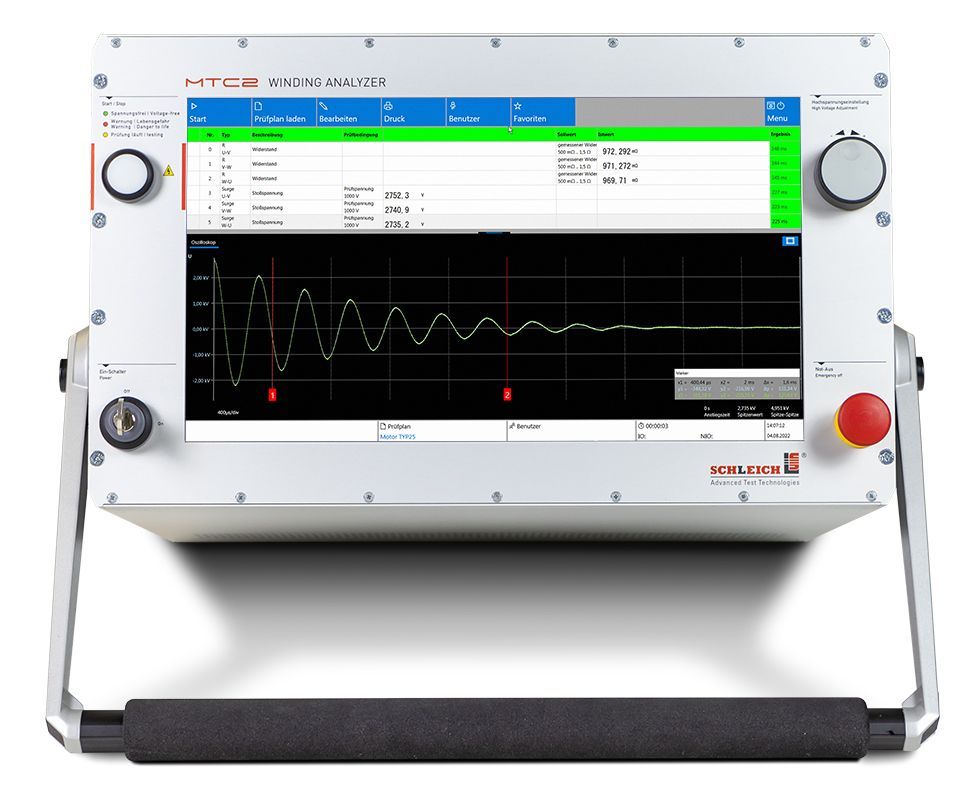
MTC2 R7 12 kV | R
surge test 0 – 12 kV
resistance 4-wire measurement
Inductance Capacitance Test NO
insulation 0 – 12 kV ˭max. 500 GΩ
polarization index Vmax like surge test
high voltage DC 0 – 12 kV ˭ test terminals T1, T2, T3, Y, frame
test cover possible
delivery order-related manufacturing
Test leads plug-in on the right side of the device
Number of test leads 5 | automatic switch-over in the test device
Housing test lead 1 | stator/motor frame
Kelvin clamps optional
Surge capacitance 100 nF; customer-specific adaptation possible
Surge energy 7,1J
Surge current 800 A; customer-specific adaptation possible
Pulse rise time 100 – 500 ns; according to IEC 60034-18-41
Refresh rate 5 - 8 Hz
Partial discharge
-
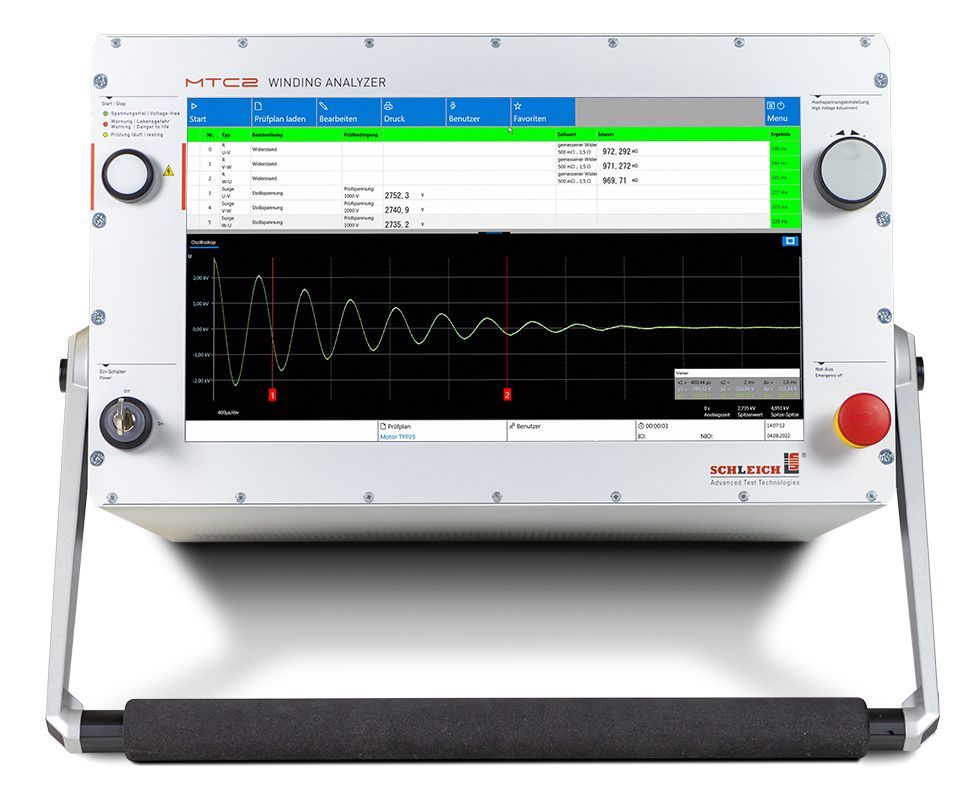
MTC2 R7 12 kV | RLC
surge test 0 – 12 kV
resistance 4-wire measurement
Inductance Capacitance Test YES
insulation 0 – 12 kV ˭max. 500 GΩ
polarization index Vmax like surge test
high voltage DC 0 – 12 kV ˭ test terminals T1, T2, T3, Y, frame
test cover possible
delivery order-related manufacturing
Test leads plug-in on the right side of the device
Number of test leads 5 | automatic switch-over in the test device
Housing test lead 1 | stator/motor frame
Kelvin clamps optional
Surge capacitance 100 nF; customer-specific adaptation possible
Surge energy 7,1J
Surge current 800 A; customer-specific adaptation possible
Pulse rise time 100 – 500 ns; according to IEC 60034-18-41
Refresh rate 5 - 8 Hz
Partial discharge
-
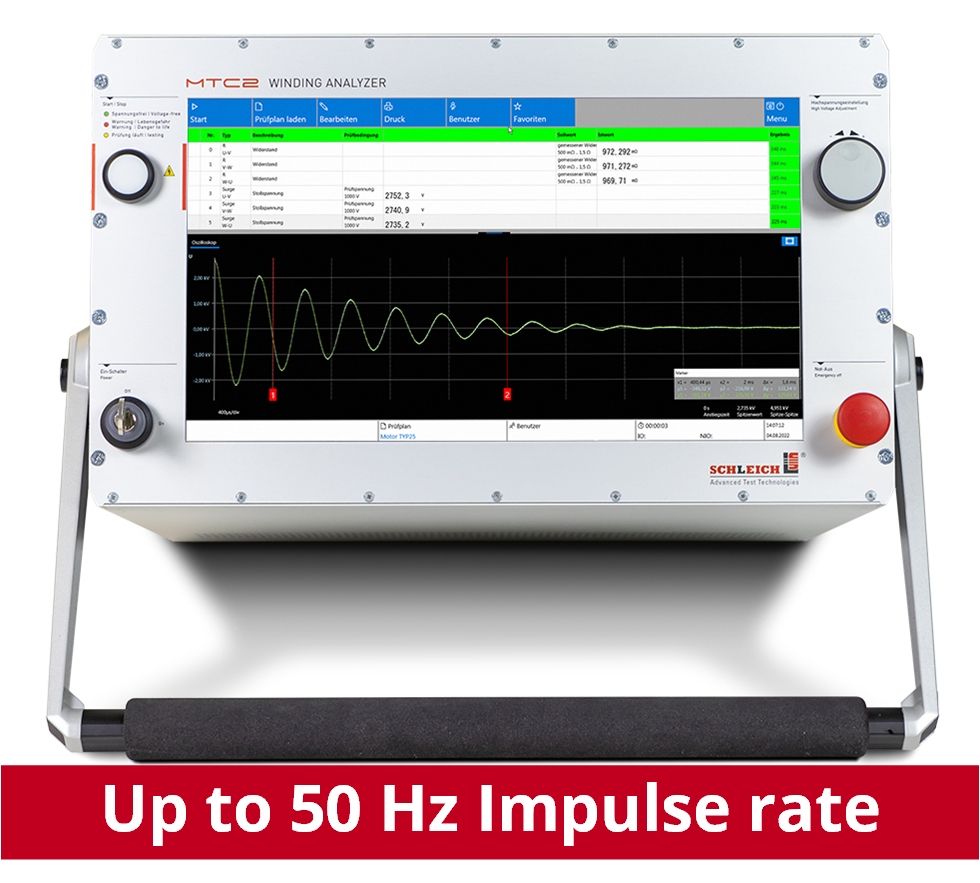
MTC2 R7 12 kV | R | PD
Test methods - Surge · R · PD
surge test 0 – 12 kV
resistance 4-wire measurement
Inductance Capacitance Test NO
insulation 0 – 12 kV ˭max. 500 GΩ
polarization index Vmax like surge test
high voltage DC 0 – 12 kV ˭ test terminals T1, T2, T3, Y, frame
test cover possible
delivery order-related manufacturing
Test leads plug-in on the right side of the device
Number of test leads 5 | automatic switch-over in the test device
Housing test lead 1 | stator/motor frame
Kelvin clamps optional
Surge capacitance 100 nF; customer-specific adaptation possible
Surge energy 7,1J
Surge current 800 A; customer-specific adaptation possible
Pulse rise time 100 – 500 ns; according to IEC 60034-18-41
Refresh rate 40 - 50Hz
Partial discharge
- yes

MTC2 R7 15 kV | R | PD
Test methods - Surge · R · PD
surge test 0 – 15 kV
resistance 4-wire measurement
Inductance Capacitance Test NO
insulation 0 – 15 kV ˭max. 500 GΩ
polarization index Vmax like surge test
high voltage DC 0 – 15 kV ˭ test terminals T1, T2, T3, Y, frame
test cover possible
delivery order-related manufacturing
Test leads plug-in on the right side of the device
Number of test leads 5 | automatic switch-over in the test device
Housing test lead 1 | stator/motor frame
Kelvin clamps optional
Surge capacitance 100 nF; customer-specific adaptation possible
Surge energy 11,25J
Surge current 800 A; customer-specific adaptation possible
Pulse rise time 100 – 500 ns; according to IEC 60034-18-41
Refresh rate 40 - 50Hz
Partial discharge
- yes
NAICS Codes
334515,
54138, 811219,811310
Cage Code
4P2J9
Duns Number
79-119-1351
Contact Info:
MOTOR DIAGNOSTIC SYSTEMS, INC.
inside.sales@mdsusa.net
Sales: +1 (970) 461-1348
or +1(877) 461-1348
Fax: +1 (866) 223-0800
Business Hours
- Mon - Fri
- -
- Sat - Sun
- Closed
All Rights Reserved | Motor Diagnostic Systems Powered by The Way Consulting



